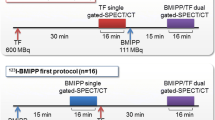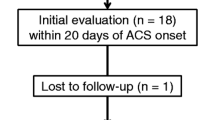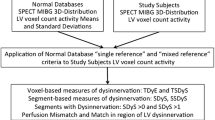Abstract
Several clinical studies have shown that iodine-123 labelled 15-(p-iodophenyl)-3-(R,S)-methylpentadecanoic acid (BMIPP) uptake is often lower than the uptake of perfusion tracers in patients with ischaemic heart disease. However, BMIPP accumulation may not decrease during the acute phase of a stunned myocardium in patients with acute coronary syndrome. We evaluated serial changes in BMIPP and perfusion tracer uptake in the myocardium after ischaemia. We performed a 20-min left coronary artery occlusion followed by reperfusion in male Wister rats. One hour after the reperfusion, echocardiography was performed. Intravenous injection of iodine-125 labelled BMIPP and thallium-201 was performed 1 day (acute group) and 5 days (subacute group) after the operation. To determine the myocardial distribution of 125I-BMIPP and 201Tl, dual-tracer autoradiography was conducted. We identified regions of interest in the anterolateral wall as an area at risk and in the inferoseptum as a remote control area. The anterolateral wall/inferoseptum ratio (A/I ratio) was calculated to compare the distributions of 125I-BMIPP and 201Tl. Coronary occlusion induced hypokinesia in the anterolateral region 1 h after the reperfusion. The A/I ratio of 125I-BMIPP was significantly higher than that of 201Tl in the acute group (1.01±0.15 vs 0.80±0.23, P<0.001). On the other hand, there was no significant difference between the A/I ratios of 125I-BMIPP and 201Tl in the subacute group (0.88±0.18 vs 0.85±0.18). Two rats showed a significantly lower A/I ratio of 125I-BMIPP than 201Tl in the subacute phase. These data suggest that BMIPP uptake is preserved despite a decrease in perfusion in the acute phase after ischaemia. In the subacute phase, on the other hand, BMIPP uptake is similar to or even lower than thallium uptake. Since BMIPP uptake may change with time after ischaemia, careful interpretation of BMIPP uptake after ischaemia is required in a clinical setting.





Similar content being viewed by others
References
Goodman MM, Kirsch G, Knapp FF Jr. Synthesis and evaluation of radioiodinated terminal p-iodophenyl-substituted α- and β-methyl-branched fatty acids. J Med Chem 1984; 27:390–397.
Knapp FF Jr, Ambrose KR, Goodman MM. New radioiodinated methyl-branched fatty acids for cardiac studies. Eur J Nucl Med 1986; 12:S39–S44.
Knapp FF Jr, Kropp J, Goodman MM, et al. The development of iodine-123-methyl-branched fatty acids and their applications in nuclear cardiology. Ann Nucl Med 1993; 7(Suppl II):S1–S14.
Tamaki N, Kawamoto M, Yonekura Y, et al. Regional metabolic abnormality in relation to perfusion and wall motion in patients with myocardial infarction: assessment with emission tomography using iodinated branched fatty acid analogue. J Nucl Med 1992; 33:659–667.
Franken PR, De Geeter F, Dendale P, Demor D, Block P, Bossuyt A. Abnormal free fatty acid uptake in subacute myocardial infarction after coronary thrombolysis: correlation with wall motion and inotropic reserve. J Nucl Med 1994; 35:1758–1765.
Kawamoto M, Tamaki N, Yonekura Y, et al. Combined study with I-123 fatty acid and thallium-201 to assess ischemic myocardium: comparison with thallium redistribution and glucose metabolism. Ann Nucl Med 1994; 8:847–854.
De Geeter F, Franken PR, Knapp FF Jr, Bossuyt A. Relationship between flow and fatty acid metabolism in subacute myocardial infarction: a study by means of99mTc-sestamibi and 123I-β-methyl-iodo-phenyl pentadecanoic acid. Eur J Nucl Med 1994; 21:283–291.
Furutani Y, Shiigi T, Nakamura Y, et al. Quantification of area at risk in acute myocardial infarction by tomographic imaging. J Nucl Med 1997; 38:1875–1882.
Hambye AS, Vervaet A, Dobbeleir A, Dendale P, Franken P. Prediction of functional outcome by quantification of sestamibi and BMIPP after acute myocardial infarction. Eur J Nucl Med 2000; 27:1494–1500.
Kawai Y, Tsukamoto E, Nozaki Y, Kishino K, Kohya T, Tamaki N. Use of123I-BMIPP single-photon emission tomography to estimate areas at risk following successful revascularization in patients with acute myocardial infarction. Eur J Nucl Med 1998; 25:1390–1395.
Ito K, Sugihara H, Kawasaki T, Katoh S, Azuma A, Nakagawa M. Dynamic changes in cardiac fatty acid metabolism in the stunned human myocardium. Ann Nucl Med 2001; 15:343–350.
Miller DD, Gill JB, Livni E, et al. Fatty acid analogue accumulation: a marker of myocyte viability in ischemic-reperfused myocardium. Circ Res 1988; 63:681–693.
Nishimura T, Sago M, Kihara K, et al. Fatty acid myocardial imaging using123I-β-methyl-iodophenyl pentadecanoic acid (BMIPP): comparison of myocardial perfusion and fatty acid utilization in canine myocardial infarction (occlusion and reperfusion model). Eur J Nucl Med 1989; 15:341–345.
Hirai T, Nohara R, Ogoh S, et al. Serial evaluation of fatty acid metabolism in rats with myocardial infarction by pinhole SPECT. J Nucl Cardiol 2001; 8:472–481.
Bilheimer DW, Buja LM, Parkey RW, Bonte FJ, Willerson JT. Fatty acid accumulation and abnormal lipid deposition in peripheral and border zones of experimental myocardial infarcts. J Nucl Med 1978; 19:276–283.
Straeter-Knowlen IM, Evanochko WT, den Hollander JA, et al.1H NMR spectroscopic imaging of myocardial triglycerides in excised dog hearts subjected to 24 hours of coronary occlusion. Circulation 1996; 93:1464–1470.
Christiansen K, Jensen PK. Membrane-bound lipid particles from beef heart. Biochim Biophys Acta 1972; 260:449–459.
Fujibayashi Y, Yonekura Y, Kawai K, et al. Basic studies on I-123-beta-methyl-p-iodophenylpentadecanoic acid (BMIPP) for myocardial functional diagnosis: effect of beta-oxidation inhibitor. Jpn J Nucl Med 1988; 25:1131–1135.
Hosokawa R, Nohara R, Fujibayashi Y, et al. Myocardial kinetics of iodine-123-BMIPP in canine myocardium after regional ischemia and reperfusion: implications for clinical SPECT. J Nucl Med 1997; 38:1857–1863.
Weber DA, Ivanovic M, Franceschi D, et al. Pinhole SPECT: an approach to in vivo high resolution SPECT imaging in small laboratory animals. J Nucl Med 1994; 35:342–348.
Yukihiro M, Inoue T, Iwasaki T, Tomiyoshi K, Erlandsson K, Endo K. Myocardial infarction in rats: high-resolution single-photon emission tomographic imaging with a pinhole collimator. Eur J Nucl Med 1996; 23:869–900.
Yamamichi Y, Kusuoka H, Morishita K, et al. Metabolism of iodine-123-BMIPP in perfused rat hearts. J Nucl Med 1995; 36:1043–1050.
Kropp J, Eisenhut M, Ambrose KR, Knapp FF Jr, Franke WG. Pharmacokinetics and metabolism of the methyl-branched fatty acid (BMIPP) in animals and humans. J Nucl Med 1999; 40:1484–1491.
Morishita S, Kusuoka H, Yamamichi Y, Suzuki N, Kurami M, Nishimura T. Kinetics of radioiodinated species in subcellular fractions from rat hearts following administration of iodine-123-labelled 15-(p-iodophenyl)-3-(R,S)-methylpentadecanoic acid (123I-BMIPP). Eur J Nucl Med 1996; 23:383–389.
Hale SL, Kloner RA. Effect of early coronary artery reperfusion on infarct development in a model of low collateral flow. Cardiovasc Res 1987; 21:668–673.
Yamashita N, Hoshida S, Taniguchi N, Kuzuya T, Hori M. Whole-body hyperthermia provides biphasic cardioprotection against ischemia/reperfusion injury in the rat. Circulation 1998; 98:1414–1421.
McNulty PH, Jagasia D, Cline GW, et al. Persistent changes in myocardial glucose metabolism in vivo during reperfusion of a limited-duration coronary occlusion. Circulation 2000; 101:917–922.
McCall D, Zimmer LJ, Katz AM. Kinetics of thallium exchange in cultured rat myocardial cells. Circ Res 1985; 56:370–376.
Takahashi N, Reinhardt CP, Marcel R, Leppo JA. Myocardial uptake of99mTc-tetrofosmin, sestamibi, and 201Tl in a model of acute coronary reperfusion. Circulation 1996; 94:2605–2613.
Fujiwara S, Takeishi Y, Atsumi H, Takahashi K, Tomoike H. Fatty acid metabolic imaging with iodine-123-BMIPP for the diagnosis of coronary artery disease. J Nucl Med 1997; 38:175–180.
Tateno M, Tamaki N, Kudoh T, et al. Assessment of fatty acid uptake in patients with ischemic heart disease without myocardial infarction. J Nucl Med 1996; 37:1981–1985.
Yamabe H, Fujiwara S, Rin K, et al. Resting123I-BMIPP scintigraphy for detection of organic coronary stenosis and therapeutic outcome in patients with chest pain. Ann Nucl Med 2000; 14:187–192.
Kawai Y, Tsukamoto E, Nozaki Y, Morita K, Sakurai M, Tamaki N. Significance of reduced uptake of iodinated fatty acid analogue for the evaluation of patients with acute chest pain. J Am Coll Cardiol 2001; 38:1888–1894.
Tamaki N, Morita K, Kuge Y, Tsukamoto E. The role of fatty acids in cardiac imaging. J Nucl Med 2000; 41:1525–1534.
Acknowledgements
We thank Professors S. Nishi, K. Miyasaka and T. Ohnishi of the Central Institute of Isotope Science, Hokkaido University, for supporting this work. We also thank Nihon Medi-Physics Co. Ltd. (Tokyo, Japan) for the generous donation of 125I-BMIPP.
Author information
Authors and Affiliations
Corresponding author
Rights and permissions
About this article
Cite this article
Noriyasu, K., Mabuchi, M., Kuge, Y. et al. Serial changes in BMIPP uptake in relation to thallium uptake in the rat myocardium after ischaemia. Eur J Nucl Med Mol Imaging 30, 1644–1650 (2003). https://doi.org/10.1007/s00259-003-1305-z
Received:
Accepted:
Published:
Issue Date:
DOI: https://doi.org/10.1007/s00259-003-1305-z




